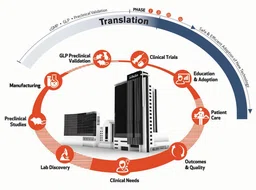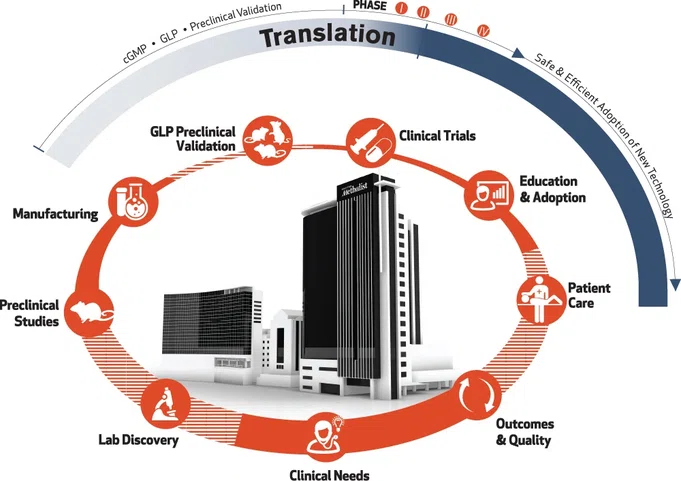
President’s letter
2020 Metrics
Cycle of Translation
Visionary Gifts

Discovery to Clinic

Innovative Education

Translational Luminaries
Introduction
The Ann Kimbell and John W. Johnson Center for Cellular Therapeutics
The Fondren Food & Health Alliance and The Fondren Inflammation Center
Cockrell Center for Advanced Therapeutics
Paula and Joseph C. “Rusty” Walter III Translational Research Initiative
Jerold B. Katz Academy of Translational Research
result
Outcomes Research
Precision Medicine
CPRIT Funding to Drive New Discoveries in Cancer Therapeutics
Siemens Healthineers and Houston Methodist Imaging Innovation Hub Empowers Researchers to Push the Boundaries
Novel Monoclonal Antibody Treatment Halts Tumor Growth in Deadly Ovarian and Pancreatic Cancers
Houston Methodist Institute for Technology, Innovation & Education (MITIESM)
Can Devices Provide A New Treatment Option for Glioblastoma?
Houston Methodist Hospital’s new Paula and Joseph C. “Rusty” Walter III Tower offers the Most advanced treatments and innovations available
Neuroimaging Offers New Insights into Neurodegeneration
COVID-19 Studies
Restorative Medicine
Houston Methodist and Rice University Launch Center for Translational Neural Prosthetics and Interfaces
Non-invasive Spinal Stimulation Enables Paralyzed People to Stand Unassisted
Dissolvable Implants Enhance the Body’s Ability to Heal Broken Bones
Cell Encapsulation May Hold the Key to Preventing Cell Transplant Rejection
Revolutionizing the Future of Complex Valve Disease Management



Science in Service
of
Medicineresult
President's letter
2020 Metrics
Cycle of Translation
Visionary Gifts of Hope


Introduction

The Ann Kimbell and John W. Johnson Center for Cellular Therapeutics

The Fondren Food & Health Alliance and The Fondren Inflammation Center

Cockrell Center for Advanced Therapeutics

Paula and Joseph C. “Rusty” Walter III Translational Research Initiative

Jerold B. Katz Academy of Translational Research

From Discovery to Clinic


Introduction

Restorative Medicine


Houston Methodist and Rice University Launch Center for Translational Neural Prosthetics and Interfaces

Non-invasive Spinal Stimulation Enables Paralyzed People to Stand Unassisted

Dissolvable Implants Enhance the Body’s Ability to Heal Broken Bones

Cell Encapsulation May Hold the Key to Preventing Cell Transplant Rejection

Revolutionizing the Future of Complex Valve Disease Management

Precision Medicine


CPRIT Funding to Drive New Discoveries in Cancer Therapeutics


An Innovative New Tool to Enable Drug Discovery and Personalized Medicine


Devising a Novel Combination Treatment for Aggressive Double-hit Lymphoma



Expanding the RNAcore to Encompass the Entire Cycle of a Cure


Siemens Healthineers and Houston Methodist Imaging Innovation Hub Empowers Researchers to Push the Boundaries

Novel Monoclonal Antibody Treatment Halts Tumor Growth in Deadly Ovarian and Pancreatic Cancers

Houston Methodist Institute for Technology, Innovation & Education (MITIESM)


Surgical Technology Developed in MITIE Gains FDA Approval


Pushing the Frontier of the Robotics Revolution

Can Devices Provide A New Treatment Option for Glioblastoma?

Houston Methodist Hospital’s new Paula and Joseph C. “Rusty” Walter III Tower offers the Most advanced treatments and innovations available

Neuroimaging Offers New Insights into Neurodegeneration

Translational Luminaries

Cycle of Translation
A Transformational Vision for Medical Research
Houston Methodist met the challenge of translation early in the design of the Research Institute building. It houses the essential services and technology that support the full cycle of development to efficiently and effectively deliver innovations to the clinic.
Translating laboratory innovations into treatments for patients is fraught with challenges. The lack of specialized translational research resources makes it extremely difficult and expensive for most institutions to turn fundamental discoveries into tangible solutions that benefit the public. Their most promising innovations perish in the ‘Valley of Death’ before they reach the clinic. We provide support at every step of the cycle of a cure from bridge funding to technical expertise with U.S. Food and Drug Administration (FDA)- approved current good manufacturing practice (cGMP) facilities, good laboratory practice (GLP) facilities and clinical trial operations. The most promising innovations have a lifeline at Houston Methodist.
Hover over the icons to learn more
Pinch to zoom image


Clinical Trials
Teams have access to early phase trial support (pharmacokinetics and pharmacodynamics), and outpatient clinical care and study management services, including research, nursing, regulatory submissions and budget management support for all phases of clinical trials. This is the end phase of the cycle of a cure, opening the door to the future.
Clinical Needs
Clinicians and researchers form interdisciplinary teams to address their needs and clinical challenges.
Discovery
Our teams of clinicians, researchers, and collaborators from around the world have access to a full suite of technology to enable the discovery process. Interdisciplinary teams turn ideas into real solutions with sound testing and iterative design.
Preclinical Validation
Research teams have access to dedicated Translational Research Initiative bridge funds to take the most promising discoveries into preclinical and early phase clinical development.
Current Good Manufacturing Practice (cGMP) Manufacturing
Houston Methodist is equipped with FDA cGMP-compliant facilities that produce research and clinical-grade therapeutic materials and custom radiopharmaceuticals for preclinical and first-in-human studies.
Patient Care
The cycle begins and ends with the care of patients in our hospitals and clinics. Clinicians in our hospitals care for more than 800,000 patients annually, enabling them to identify the most pressing challenges in medicine and provide excellent care.
Good Laboratory Practice (GLP) Preclinical Validation
The GLP facilities at Houston Methodist perform risk, safety and efficacy assessment studies in compliance with current FDA guidelines in preclinical models. Adherence to GLP standards is required for safety studies in order to move to clinical trials.
Outcomes & Quality
A key component of leading medicine is our culture of quality, safety and innovation. As part of the system-wide goals for quality improvement and patient safety, we develop our education programs to incorporate high reliability organization principles and use team-based training approaches to maximize patient outcomes.
Education & Adoption
Throughout our system, we’re building interprofessional education programs that employ the latest strategies, including simulation, to facilitate the safe and efficient adoption of new technologies as they’re approved for clinical use. Bringing a new innovation from the completion of clinical trials to clinic adoption is very time and resource intensive, needing 10 years and $1 billion, on average.

Patient Care
The cycle begins and ends with the care of patients in our hospitals and clinics. Clinicians in our hospitals care for more than 800,000 patients annually, enabling them to identify the most pressing challenges in medicine and provide excellent care.

Outcomes & Quality
A key component of leading medicine is our culture of quality, safety and innovation. As part of the system-wide goals for quality improvement and patient safety, we develop our education programs to incorporate high reliability organization principles and use team-based training approaches to maximize patient outcomes.

Clinical Needs
Clinicians and researchers form interdisciplinary teams to address their needs and clinical challenges.

Lab Discovery
Our teams of clinicians, researchers, and collaborators from around the world have access to a full suite of technology to enable the discovery process. Interdisciplinary teams turn ideas into real solutions with sound testing and iterative design.

Preclinical Validation
Research teams have access to dedicated Translational Research Initiative bridge funds to take the most promising discoveries into preclinical and early phase clinical development.

Current Good Manufacturing Practice (cGMP) Manufacturing
Houston Methodist is equipped with FDA cGMP-compliant facilities that produce research and clinical-grade therapeutic materials and custom radiopharmaceuticals for preclinical and first-in-human studies.

Good Laboratory Practice (GLP) Preclinical Validation
The GLP facilities at Houston Methodist perform risk, safety and efficacy assessment studies in compliance with current FDA guidelines in preclinical models. Adherence to GLP standards is required for safety studies in order to move to clinical trials.

Clinical Trials
Teams have access to early phase trial support (pharmacokinetics and pharmacodynamics), and outpatient clinical care and study management services, including research, nursing, regulatory submissions and budget management support for all phases of clinical trials. This is the end phase of the cycle of a cure, opening the door to the future.

Education & Adoption
Throughout our system, we’re building interprofessional education programs that employ the latest strategies, including simulation, to facilitate the safe and efficient adoption of new technologies as they’re approved for clinical use. Bringing a new innovation from the completion of clinical trials to clinic adoption is very time and resource intensive, needing 10 years and $1 billion, on average.










